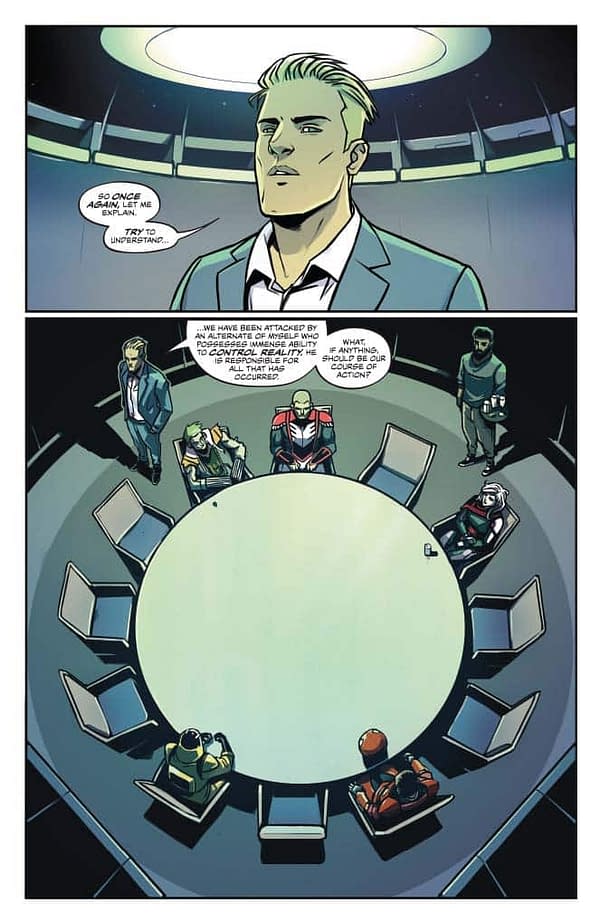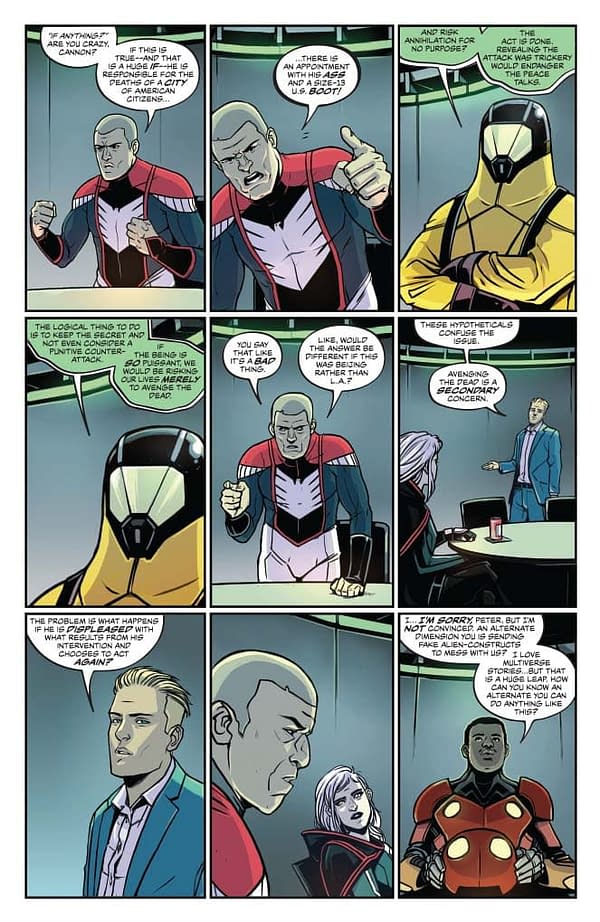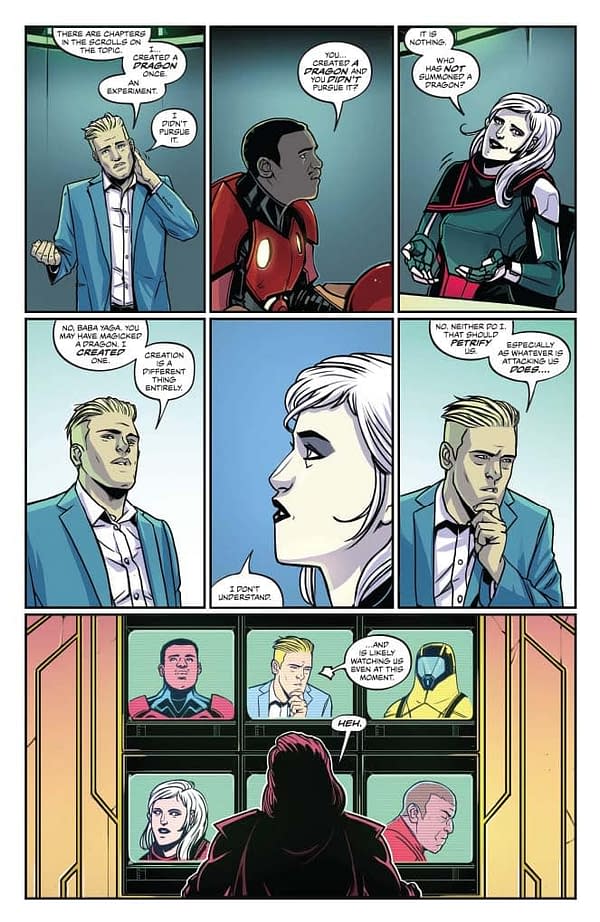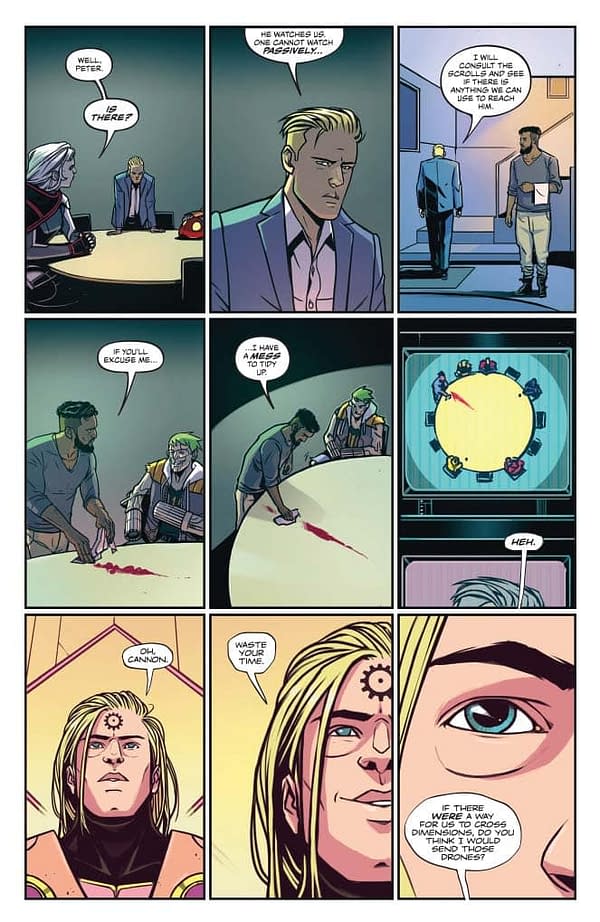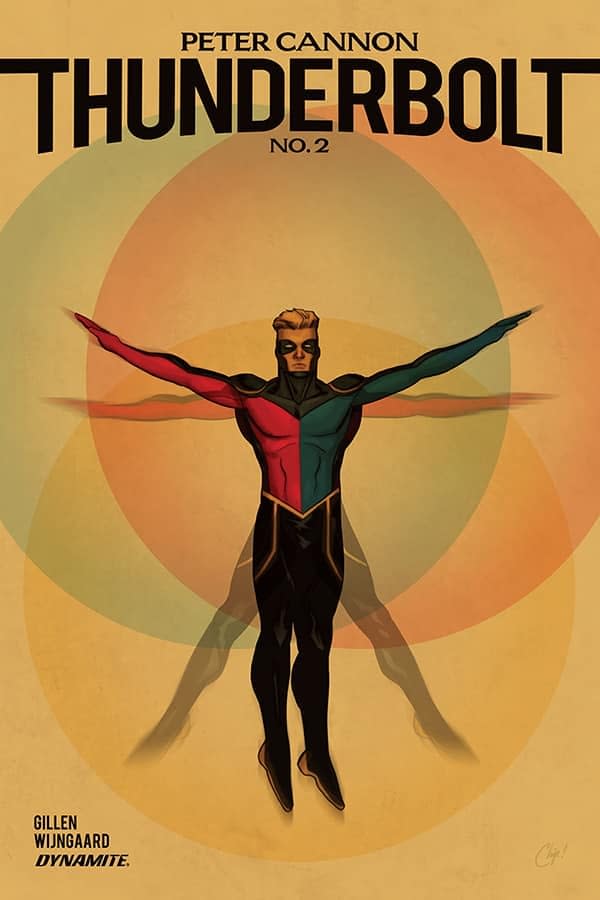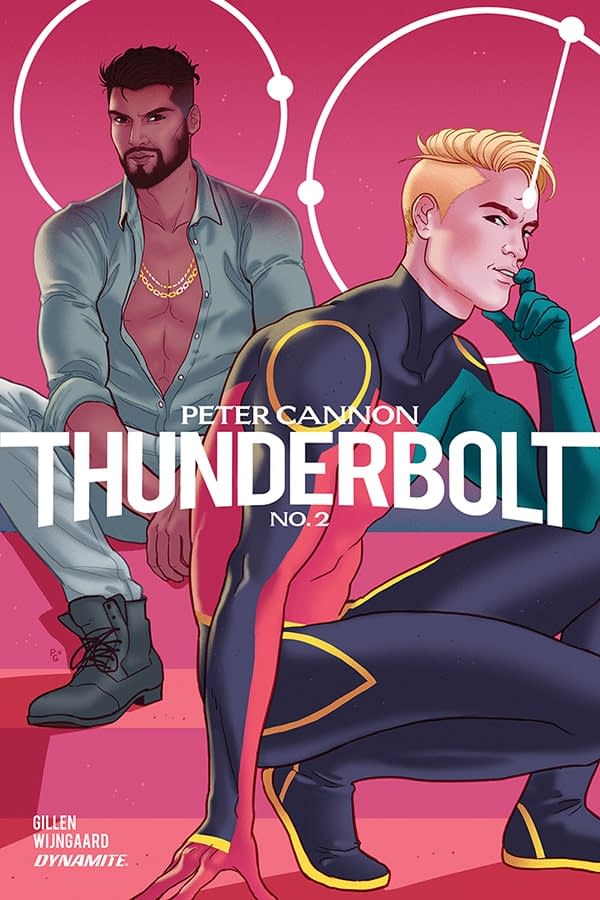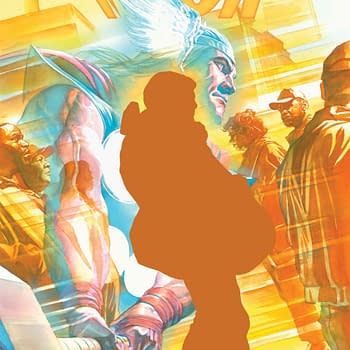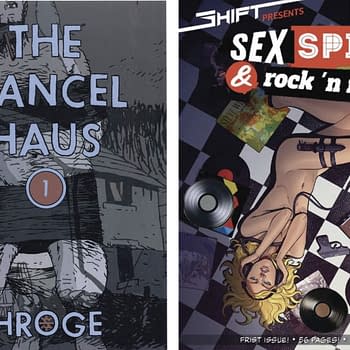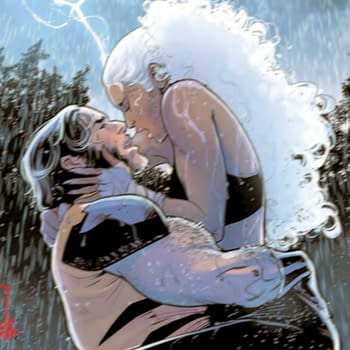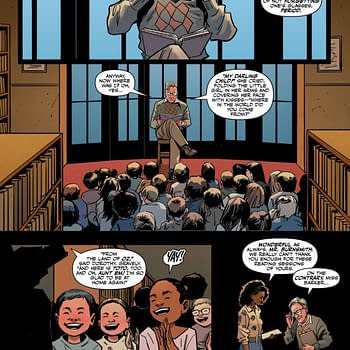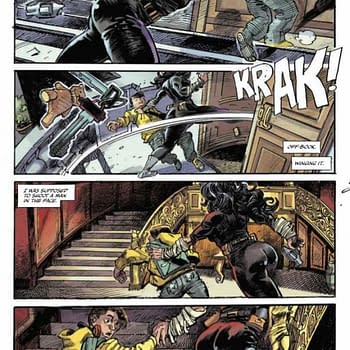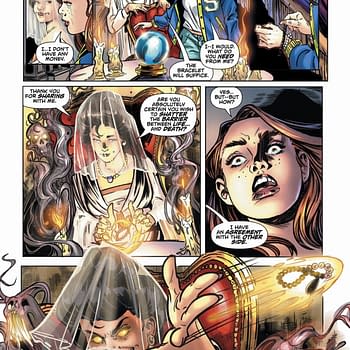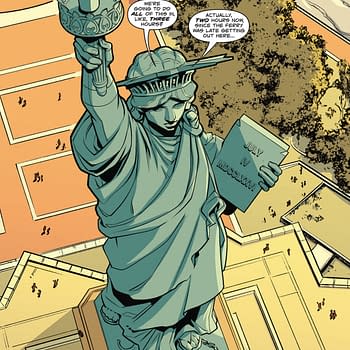Posted in: Comics | Tagged:
'Raspberries Work' – Kieron Gillen's Writer's Commentary on Peter Cannon: Thunderbolt #2
Kieron Gillen does his Writer's Commentary thing on Peter Cannon: Thunderbolt #2, out last week from Dynamite.
Hullo, it's me again. I'm writing these at the start of the day, rather than in a desperate rush at the end, so I've got high hopes these won't be a complete typo-ridden mess and I won't claim the creator of Thunderbolt was a 1960s comic book character.
Page 1
The first issue of Thunderbolt is many things, but at the core, it's something of a shaggy dog tail. The structure is a bleak joke, and it's drawing lines between Watchmen and its late 90s successors (namely The Authority, whose mode I'd argue a good chunk of mainstream superhero comics are operating in.) A lot about issue 1's appeal is "do you find this joke funny or not?" Obviously, you only do that once.
I realized when writing that [Warren] Ellis was the big influence on the first issue. Then, as I progressed, I realized that each issue was (at the core) a riff on a certain strand of post-Watchmen superhero comics. With the playful dimension skipping, I was thinking this as the Morrisonian weird-pop issue, and that school. A few other things – NextWave's influence is in there, which was an early example of the school that found its feet in the 2010s – but "the Morrison issue" would be the way I'd describe it. Except now, when I sit back and look at this beast, I realize that's not really true. It's not Morrison. It's me. This issue is all my bullsh*t.
The first tell is that we start the issue with a homage to the Watchmen homage in the middle of The Wicked + the Divine, my most successful post-Watchmen comic. This is the scene where Baal first talks about the great Darkness, with individuals mapped onto the space.
Anyway – that's the layout. Once more, I love how epically condescending Peter Cannon is. Worth noting the choice in powering through – Cannon's giving information he didn't say at the end of last episode. He's a smart guy. Let's assume he figured it out, and get a move on.
Page 2
Back to the nine panel! We get a chance to live with our analogues some more. I'll admit, I quite enjoy the blustering not-quite-getting-it of Supreme Justice.
"Avenging the dead is a secondary concern" is Cannon at this point all over. That makes me shudder. It's an odd one – that there's a lot that is meant to be funny in this, but it also juxtaposes with some 100% deadly serious stuff. Which is one of my go to moves, right?
(I've just deleted two paragraphs of a random wander into discussing the works of 90s games journalist, J. Nash. You folks don't need to know that.)
Oh – look at that expression in panel 7. Caspar nails that one.
Panel 9 – I believe I said "You know –I think Pyrophorus is an Indian guy. In fact, he should look like Ram V." It's clearly that Caspar felt he couldn't render the beautiful flowing locks of Ram. Such a thing is clearly impossible for mortals.
Page 3
The "Dragon" is one of the weirder bits in the original Peter Cannon stories. For most of it, he's "just" peak human, doing these impressive, but standard superhero feats. Like, Batman would do them. Then, in one episode, he makes a Dragon. This is such a leftfield moment that it's the heart of the original Dynamite run on the book too. While I was playing with the "Ozymandias As Doctor Manhattan" part in my original conception, it was when I read the bit with the Dragon, I realized it wasn't nearly as big a stretch as I thought. This stuff is just there.
I'll say this – of the core team around Thunderbolt, Baba Yaga is the person I'm least happy with. Caspar gave her an amazing design, but as the characters are mixologist riffs on pre-existing ingredients, her ingredients lack the big personality quirks. That Nucleon is a more striking personality is because she's riffing on the Hulk and Doctor Manhattan – two big, strong voices. Nightshade meets Black Widow gives me a role, but not a big personality that you can get across in a line of dialogue. She does some fun stuff, but that she's the weakest of the supporting cast does bug me.
I loved the abashed look of Cannon in the first panel. Mary's coloring in the last panel, immediately clearly Not In the Same Universe is great. Slight distortion and the colors warping to a 1980s palette is great.
Page 4
I did play with the idea of making the raspberries beans, but that seemed too much. Also I believe Editor Matt noted that at least Raspberries would be in the room. Why would beans be in the room? Would the Test have carried a mouthful of beans from arriving?
(Well, yeah, maybe he would have. He's a weirdo. But still – raspberries work.)
The Test gets a bigger role than the rest in this meeting, for obvious reasons. He's going away, so this is his chance to show what he's about. He's about absurdity.
The Test basically came from looking at the tradition Rorschach is part of – as in, the edgy team loner. This includes Wolverine, fairly obviously (which was the inspiration for the gun hands) but also includes Deadpool. Thinking about Deadpool made me think about what could make someone have the fourth-wall-breaking personality without going full Gwenpool, and I ended up as a videogame-character-as-person. But you also end up with "what if Deadpool believed in absurdity in the same way that Rorschach believes in what he believed." That's laid out in panel 8, and is the first SHAMELESS! Moment in the issue.
(Rorschach's and The Test's responses are both based on what they see as the fundamental absurdity of life, of course.)
If I had another 3 panels, I'd totally have had The Test try to moon the sky.
Page 5
Let's start cutting this short, as I'm rambling.
SHAMELESS! MORE SHAMELESS!
Did I link to my speech about Watchmen from 2014 last time? If not, here it is. It's me breaking down a lot of Watchmen's techniques.
Page 6-7
I really like these two pages. In an issue which is all horror, weirdness and jokes, a hard cut to do a straight, emotional scene is a thrill. Page 6 is just some wonderful comics from Caspar. It's rock solid, intimate and just sad. Page 7's conversation is interesting in lots of ways, I hope, but page 6 is just nice comics.
The thing about nine panels, which is really basic, is just the extra couple of moments in a page. Standard U.S. comics on a standard page goes with five panels. This is a seven panel page, where we get an establishing shot, and six other moments. On a normal page, we'd lose three of those moments. It would work, but you don't get to linger and make those pauses meaningful. The Page as stanza approach (a phrase I picked up from Ellis – I'm not actually sure if it's his) means that the page is the unit of singular aesthetic purpose. As in, you take the page as a singular THING. Having the extra beats in there means you can handle more subtle moments in the primary unit of the comic. That seems particularly key in this scene – because without the extra silence and the pauses, the scene simply doesn't exist. This is a page about silence, two men being together, and those pauses.
I digress.
Cannon and Tabu aren't lovers in the original comics. Clearly there was no intent in the 1960s, but reading those original books in the 21st century it's hard to not read them that way. That said, I was reticent to just make that text. I've done a lot of queer cast books. Making Peter Cannon and Tabu lovers seems the most obvious Kieron-Gillen-Move imaginable.
(See what I mean by this issue being me?)
Yet at the same time, it's what those two characters seemed they needed. I love writing close platonic friendships (there's not enough of that either, frankly) but they seemed like lovers. And then it struck me – not lovers, but ex-lovers. That's something else, and something I haven't written before, and felt really interesting. I'm writing two men with a life behind them – they're both 40. Let's go with the life.
"It was always easier for you to be superhuman" seems to be one of those key lines, right?
Page 8-9-10-11-12
And after showing some actual heart, we get back to the grinning. I feel a lot like Tabu looks in panel 5 on page 8. Just the "Hey – look at this. Go with me."
This is a sequence we had to work a few times, and add some minor details to hold together – the banner was a late addition in the first panel on page 8, just to ensure everyone can see how we're going with it.
I smile at Baba Yaga in panel 4 of 8. Her frustration with all this formalism is one of the bits I do like about her.
Basically, "The nine panel grid as superpower" was set up in last issue as a conceptual issue. Cannon understands the 9 panel grid, so does things no-one else can. This builds on that, and…
That page 10 full reveal with that line? That's 100% an "I've either got you or you're closing the book at this point" moment, but it's a pure burst of whatever I love in this kind of comic. Some amazing font work, of course – working out how titles interject with a nine panel grid is something that Caspar and Hassan could talk around. I sent a lot of reference in terms of how it could be done.
Page 12 – the Tabu's turn to reader just charms me – once again, that large single row being used to skip between the dimensions. Mary's shine on the walls is just intoxicating. I want to lick them.
(The Watchmen banner being visible at the bottom of panel 1 on page 12 was a late addition too – we really had to make it clear what the trick was.)
I really can't get over Hassan's choices for the alt-dimension balloons. I love him. You hear that, Hassan? I LOVE YOUuUUU.
Page 13
So, you've got a double page spread, and you've started it on a right facing page, what do you do? What you do is magic up a new page, from thin air.
Page 14-15
When I showed this issue to a friend, he paraphrased the book as "CRISIS ON INFINITE WATCHMEN." I think that's a useful take.
I love this kind of stuff – it's very Morrisonian, but it's also a technique Jamie and I used a lot in Young Avengers. A bit of grid as a life-raft between dimensions also brings to mind certain raft imagery in Watchmen.
I do like how well The Test handles interdimensional travel. Never change, The Test.
I called the key idea in each of these Watchmen-infected worlds – some are just very basic, while others are riffs on other bits of the whole superhero world. Caspar nails them – the three on the second page of the spread are just wonderful. Also, Mary's color choices. Trying to get something which is coherent on the page, while also individualises all the worlds? That red sky in panel 6 on the second page.
Page 16-17-18-19
This trickery burns page count, of course. In basic level of a nine panel is that still get four beats on a page like this.
Also, The Test is just a sweetie. I hope he doesn't die messily in a homage to one of the more famous beats in comics history. That would just be awful.
That alt-dimensions small changes include minor things in terms of wi-fi protocols seems to be logical enough for me.
That you realize an alt-dimension you have done monstrous acts in is one thing – especially that you're so close to it. That they've done something like Thunderbolt has done to Tabu is something personal. How close am I to that?
I tend to write characters who start at a low part, either emotionally or with a serious ethical failing they'll either overcome or not. I'm not that interested in heroes. I am interested in the process of trying to be heroic. The former is a fictional flattening of reality. The latter is the sh*t we have to go through every day. Multidimensional stories have proved interesting for that – when explaining this story to Dynamite, I tried to talk about how my least favorite multidimensional stories are those who render everything weightless. As such, it's important to ground it, at every point, to the emotional reality of the characters.
Anyway – that. This scene is horrible, and obviously reveals Thunderbolt for what he is.
(Er… "Peter Cannon" is how we refer to our hero. "Thunderbolt" is how we refer to our villain. Did I say that last time?)
Page 20-21
And the last scene. This is fairly obviously homaging a couple of beats in Watchmen – the first when everyone else decides to compromise and Rorschach stands there, mask unchanging for the first time in the whole book, in the shape his mask was when he first said he would not compromise in the face or Armageddon. And the other being… well, you know. "I can't let you do that".
Panel 3 on page 20 originally had a different diss. I wrote the script before Caspar designed Thunderbolt. I had an idea he should have some of the robes of The Hooded One, which is Cannon's original villain – and also dark mirror to him. We went a different way, so the dialogue didn't work. It was…
THE TEST
Nice Cowl. Are you going to go live-role-play Dungeon Master later?
(Cont)
Or is this a HOT FUZZ thing? For the greatttter gooooood!
Which does make me smile, not least that the greater good is thematically pointed.
I mean, The Test explodes in a Rorschach test. Do I need to explicitly say this? That is what we did. The exact coloring was talked around a lot – the reds and roses and gradients really add to the mood, but the splatter is the key bit of information.
As a minor comics note, it's fun to see an actual genuine "freeze frame moment" panel. As anyone who's read Understanding Comics knows, most comic panels actually are several moments in time. This is a hyper-clarity second – which is an effect created by what Caspar did with the boots.
We originally were going to have issue 3's cover be the boot, spinning, but went another way.
Right – I've written far too much again, and I've deleted a bunch of tangents. See you next month, where we unpack the legacy of the violence of Watchmen.
Thanks for reading.


